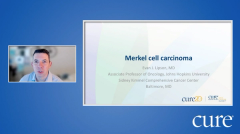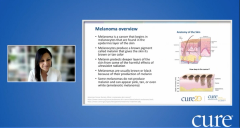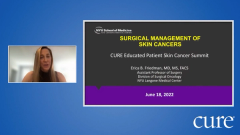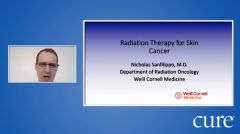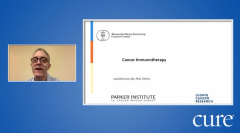
Educated Patient® Skin Cancer Summit Topical Treatments Presentation: June 18, 2022
Watch Dr. Sherrif Ibrahim, from the University of Rochester Medical Center, discuss topical treatments during the CURE Educated Patient Skin Cancer Summit.
While surgery is typically a mainstay for frontline skin cancer treatment, some cancers, if caught extremely early, can be treated with topical drugs — meaning therapies that are applied directly to the skin, explained Dr. Sherrif Ibrahim, associate professor at the University of Rochester Medical Center in New York.
At the CURE® Educated Patient® Skin Cancer Summit, Ibrahim explained that topical treatments only work for non-melanoma skin cancers that are very thin and in the early part of their development, such as superficial basal cell or squamous cell carcinomas. If this is the case, using a cream to fight the cancer may be preferred in certain situations.
Creams and Ointments
“Sometimes …it might be more advantageous to use a cream to really avoid surgery that might be debilitating, even in a place like the face, especially if it's located around the eyelids, the lips, the nose and so forth,” Ibrahim said. “As somebody that primarily treats things surgically, it becomes very difficult to tell where the actual edges of the skin cancer are and where the normal skin begins. And so, in that situation, topical treatments or creams are very handy, because we can treat well beyond the obvious visual edges of the skin cancer.”
Topical creams are applied by patients at home, so patients should discuss potential side effects that they can expect.
“We get a lot of calls from patients saying, ‘I think I’m having an allergic reaction,’” Ibrahim said. “But a lot of that is really just destruction of the skin cancer, and when you destroy skin, that leads to things like inflammation, redness, discomfort, crusting of the skin and, in some cases, bleeding, itching or other types of not-so-pleasant symptoms.”
Freezing
Another skin cancer treatment that is considered topical is the freezing of certain areas of skin using liquid nitrogen, which has a temperature colder than negative 300 degrees Fahrenheit, Ibrahim explained.
“So if something is very small, very isolated and in a very discreet area, we can aim the gun of liquid nitrogen on there and literally cause a frostbite … just absolutely destroying the skin cancer that’s there,” Ibrahim said. “It’s not the most pleasant thing to go through, and it takes several weeks to heal, but it’s really great when you have just this isolated, very discreet spot.”
Ibrahim made the analogy of thinking of skin cancer spots as weeds in a garden. Surgically removing the cancer is like plucking the weed, while the topical use of liquid nitrogen is like spraying weed killer — the former approach allows for a more exact removal, keeping other areas unharmed, while the latter could be seen as less invasive of a procedure.
When Not to Use Topical Treatments
Much research goes into developing topical treatments that can go through the stratum corneum — the upper-most layer of the skin — and these therapies are certainly not appropriate for every case of skin cancer. In fact, Ibrahim mentioned there are very few cases when topical treatments can be used.
“Topical treatments are never good for skin cancer that’s thick. Or it doesn’t necessarily need to be thick, it could just be mounted on the surface of the skin, what we would call a nodular tumor, because the creams just won’t penetrate,” Ibrahim said.
Additionally, since creams and ointments are applied by patients at home for a number of weeks, it is essential that patients follow the scheduled protocol for application.
“They do require a high degree of patient compliance, we rely on you guys after we instruct you how to put these on to do this at home,” Ibrahim said.
Looking forward, Ibrahim said that many of these drugs are also being investigated in injection form, so that in the future, patients may have even more options to treat their cancer.
“I think there’s a lot of exciting times to come,” he said.
For more news on cancer updates, research and education, don’t forget to

